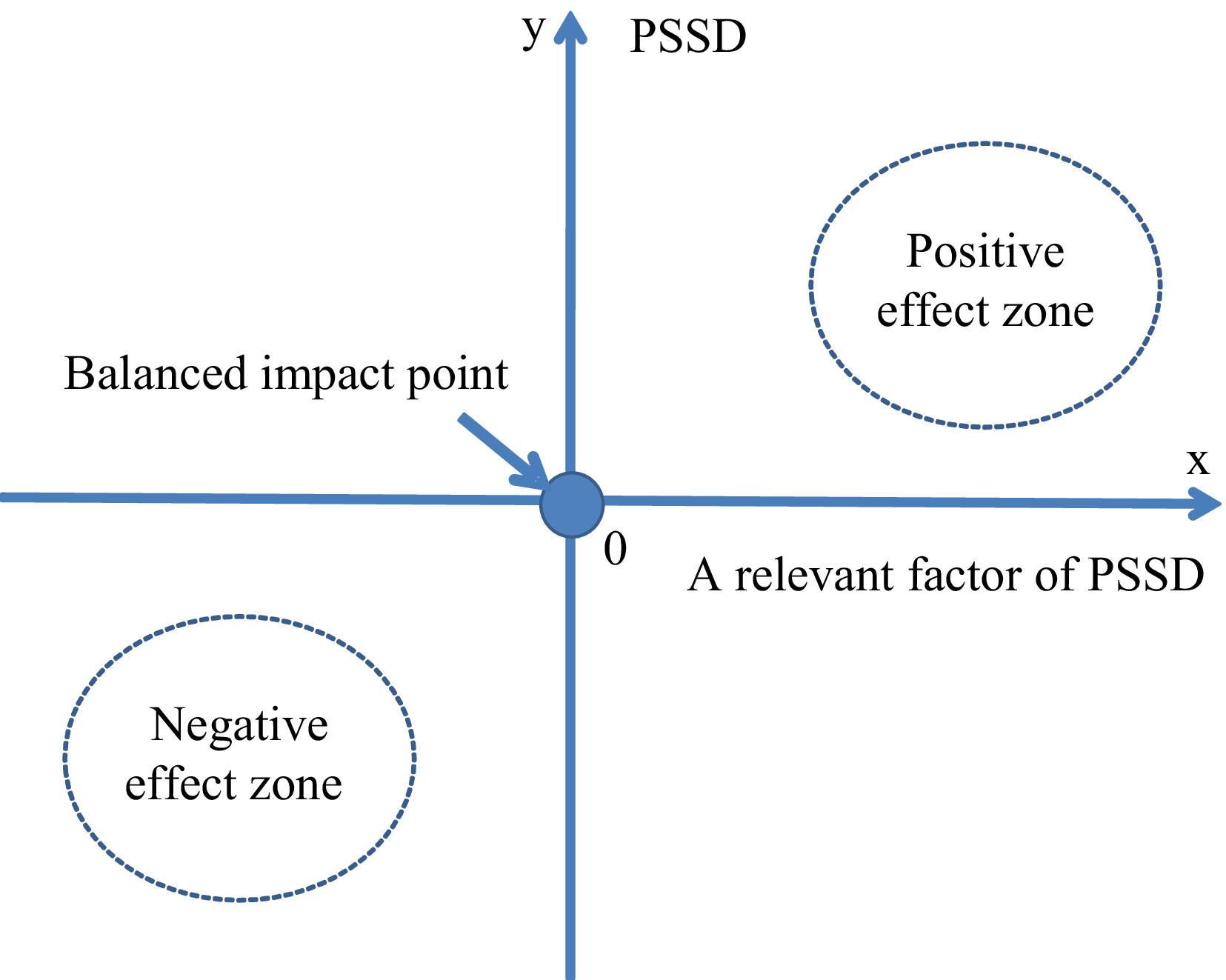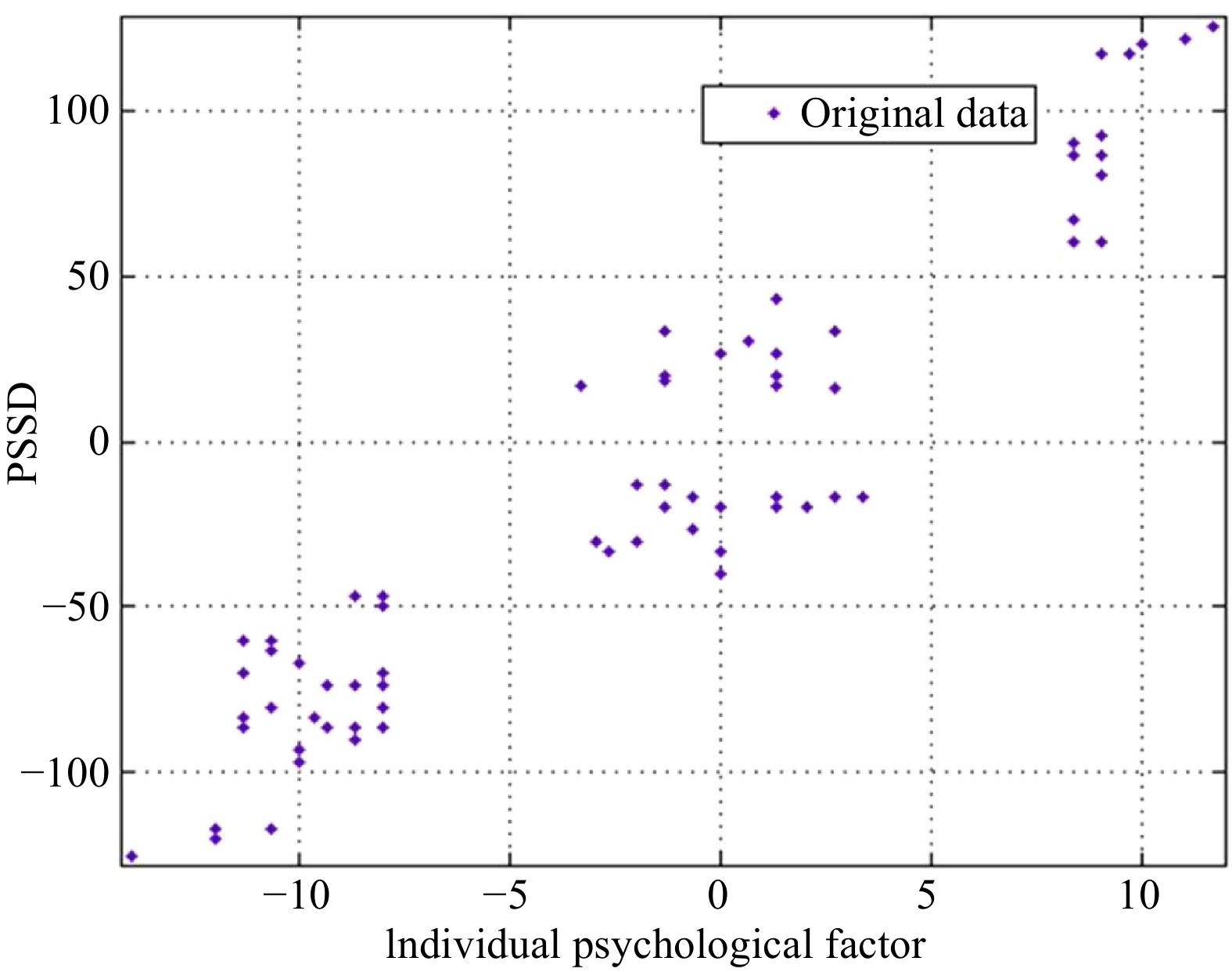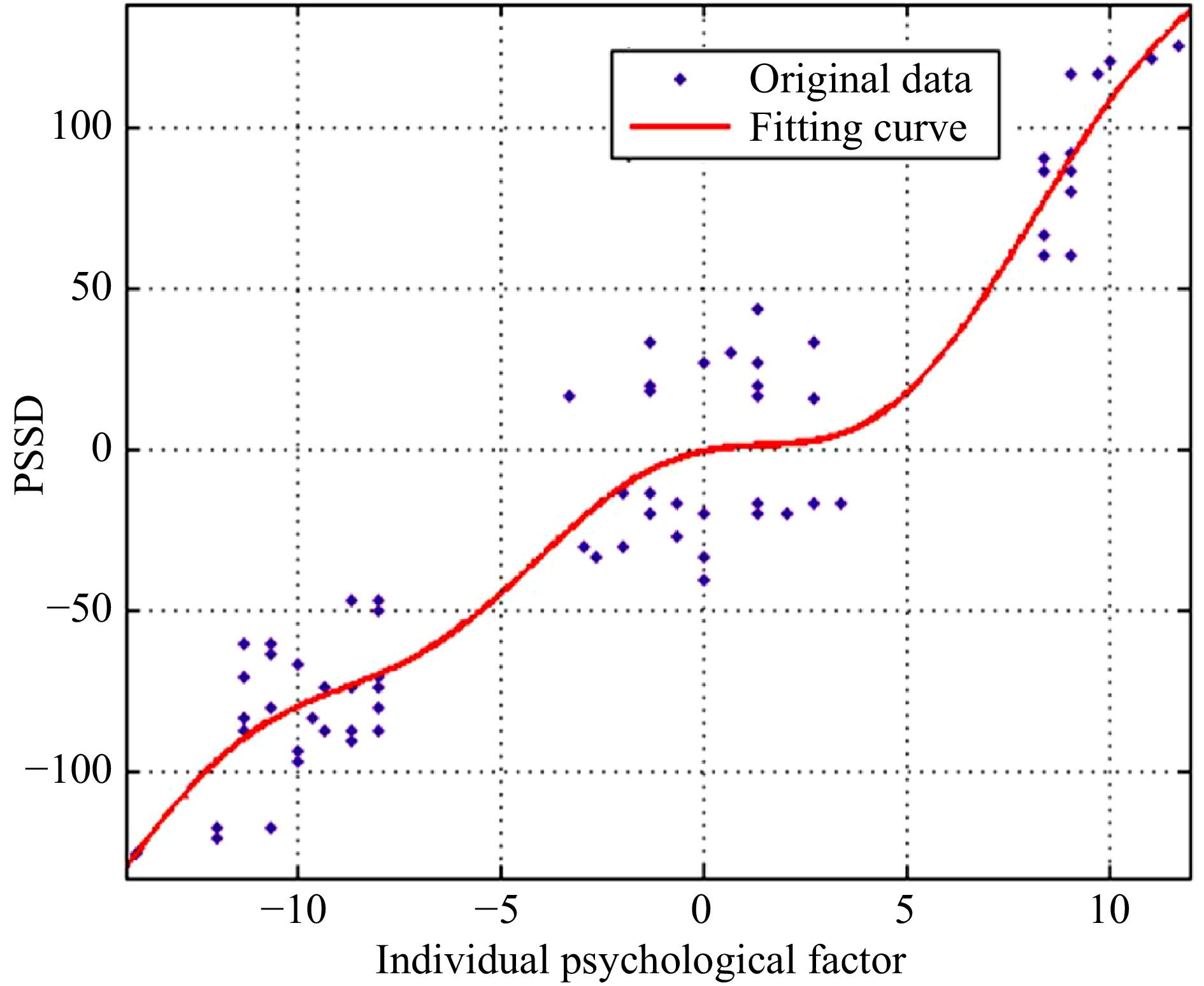-

Figure 1.
2D coordinate framework for PSSD expression.
-

Figure 2.
Scatter diagram example of original data for PSSD expression.
-

Figure 3.
Fitting curve example for PSSD and individual psychological factors.
-
a b c d e u0 1 1 1 1 1 u1 1 0 1 1 1 u2 0 0 1 1 1 u3 1 0 1 0 1 u4 1 0 1 1 1 u6 1 0 0 1 1 u6 1 0 0 1 1 u7 1 1 1 1 1 Table 1.
Literature contribution to the PSSD information sets.
-
Type of individual personality Description Triangular fuzzy interval Safe Normal and relaxed conscious state, brisk and calm, positive or intermediate emotion $ \left(5, +{\infty }\right) $ 

Non-safe Hyper-normal overstress, irritable impatient, negative emotion $ \left(-6, 6\right) $ 

Unsafe Subnormal conscious state, insensitive, negative emotion $ \left(-10, -4\right) $ 

Highly unsafe Unconscious, flippant, negative emotion $ \left(-{\infty }, -8\right) $ 

Table 2.
Descriptions and triangular fuzzy intervals for different types of individual personality in PSSD expression.
-
Type of physical condition Description Triangular fuzzy interval Safe Ample sleep, energetic, no sign of fatigue, good psychological condition $ \left(5, +{\infty }\right) $ 

Non-safe Insufficient sleep, sign of fatigue, physically unwell $ \left(-6, 6\right) $ 

Unsafe Insufficient sleep, drooping spirit, obvious fatigue, physically unpleasant $ \left(-10, -4\right) $ 

Highly unsafe Sleep extremely insufficient, numbness, severe fatigue, physical impairment $ \left(-{\infty }, -8\right) $ 

Table 3.
Descriptions and triangular fuzzy intervals for different types of physical conditions in PSSD expression.
-
Type of social influence Description Triangular fuzzy interval Safe Good interpersonal relationships, loving family, amicable group atmosphere, supportive national policy $ \left(5, +{\infty }\right) $ 

Non-safe Bad interpersonal relationships, unloving family, group atmosphere unkind, unsupportive national policy $ \left(-6, 6\right) $ 

Unsafe Bad interpersonal relationships, unloving family, group atmosphere strained, unsupportive national policy $ \left(-10, -4\right) $ 

Highly unsafe Interpersonal relationships extremely bad, severe family conflict, group atmosphere exceeding unharmonious, forbidding national policy $ \left(-{\infty }, -8\right) $ 

Table 4.
Descriptions and triangular fuzzy intervals for different types of social influence in PSSD expression.
-
Type of environmental impact Description Triangular fuzzy interval Comfortable Working and living environment perfectly suits ergonomic requirement for comfort $ \left(10, +{\infty }\right) $ 

Safe Comfortable working environment, good living environment $ \left(5, 10\right) $ 

Non-safe Barely comfortable working environment, barely satisfactory living environment $ \left(-6, 6\right) $ 

Unsafe Uncomfortable working environment, poor living environment $ \left(-10, -4\right) $ 

Highly unsafe Extremely unpleasant working environment, exceedingly poor living environment $ \left(-{\infty }, -8\right) $ 

Table 5.
Descriptions and triangular fuzzy intervals for different types of environmental impact in PSSD expression.
-
Type of PSSD Description Triangular fuzzy
intervalAbsolutely safe Extremely high safety index $ \left(100, +{\infty }\right) $ 

Highly safe Very high safety index $ \left(80, 100\right) $ 

Safe High safety index $ \left(40, 80\right) $ 

Relatively safe Relatively high safety index $ \left(0, 40\right) $ 

Relatively unsafe Relatively low safety index $ \left(-40, 0\right) $ 

Unsafe Low safety index $ \left(-80, -40\right) $ 

Highly unsafe Very low safety index $ \left(-100, -80\right) $ 

Absolutely unsafe Extremely low safety index $ \left(-{\infty }, -100\right) $ 

Table 6.
Descriptions and triangular fuzzy intervals for different types of PSSD.
-
Description 2D coordinates Conscious, relaxing, cautious, responsible, extroverted, outgoing, positive, quick learning capacity (10, 120) Conscious, relaxing, cautious, responsible, introverted, calm, positive, quick learning capacity (9.67, 116.67) Conscious, slightly nervous, careless, outgoing, irritable, positive, average learning capacity (1.33, 16.67) Conscious, slightly nervous, careless, introverted, insensitive, intermediate mood, average learning capacity (−2.67, −33.33) Conscious, hyper-normal stressed, responsible, cautious, introverted, calm, negative, relatively quick learning capacity (−0.67, −16.67) Conscious, hyper-normal stressed, careless, outgoing, extroverted, intermediate mood, poor learning capacity (−1.33, −20) Fuzzy consciousness, relaxing, responsible, cautious, introverted, calm, intermediate mood, quick learning capacity (−2, −30) Fuzzy consciousness, slightly nervous, careless, outgoing, irritable, positive, average learning capacity (−8, −73.33) Fuzzy consciousness, hyper-normal stressed, careless, outgoing, extroverted, positive, poor learning capacity (−11.33, −123.33) Slack consciousness, relaxed, careless, outgoing, extroverted, intermediate mood, quick learning capacity (2.67, 16) Table 7.
Part of original data of 2D coordinate points obtained by expert fuzzy evaluation in PSSD expression.
Figures
(3)
Tables
(7)